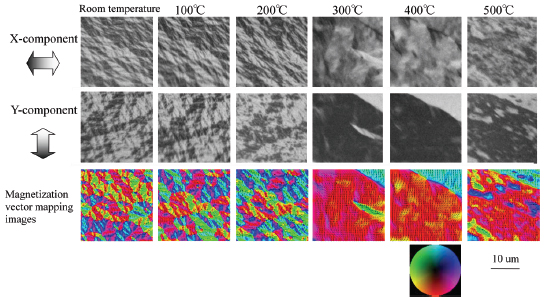Information contained in this news release is current as of the date of the press announcement, but may be subject to change without prior notice.
September 21, 2010
Contributing to magnetic material development and performance improvement of devices such as HDD
Tokyo, September 21, 2010 --- Hitachi, Ltd. (NYSE : HIT/TSE : 6501, hereafter Hitachi) today announced the development of Spin-polarized Scanning Electron Microscopy (hereafter, spin-SEM) technology for observation of magnetic domains under high temperature conditions in a magnetic field. Using this technology, changes in the magnetic domain structure of a cobalt (Co) single crystal was visualized up to 500 degrees Celsius (℃). By applying the technology developed, the temperature conditions for observing magnetic domains in a sample can be heated up to 500℃ when using only the heating unit, and up to 250℃ when used in combination with a function to apply a magnetic field of up to 1,000 Oersteds (Oe). As a result, it is now possible to fully utilize the spin-SEM feature of high-resolution magnetic domain observation while observing the effect of temperature and external magnetic field on magnetic materials. It is expected that in the future, this technology will contribute to the development of new materials for permanent magnets and performance improvements in magnetic devices such as hard disk drives (HDD), etc.
Spin-SEM is scanning electron microscopy which focuses a squeezed electron beam on a sample surface and measures the spin (the smallest unit describing magnetic property) of the secondary electrons emitted from the sample to observe the magnetic domain (the region where the spin direction is the same). It has a high resolution (10nm for Hitachi instrument) compared with other magnetic domain observation instruments and can be used to analyze magnetization vector. This method was first developed by the Central Research Laboratory of Hitachi in 1984, and since, has been developed and used by many laboratories as a method to observe micro phenomenon in magnetic devices. In recent years, there is a growing demand to observe the effect of heat or a magnetic field on the magnetic domain in studying magnetic material characteristics, such as the effect of high temperature on the thermal demagnetization process in permanent magnets or deformation of magnetic bits in HDD. In order to efficiently detect these low-energy secondary electrons, however, complex highly sensitive measuring components are positioned close to the target sample in conventional spin-SEM, and this measurement are easily affected by a drop in vacuum level due to heating, or by even a small stray magnetic field. It was difficult, therefore, to build-in a system to heat or apply a magnetic-field to a sample to control the observation conditions in spin-SEM.
In response to this need, Hitachi has developed microscopy technologies for high-temperature and magnetic-field conditions in spin-SEM systems, and succeeded in the observation of changes in the magnetic domain structures of magnetic materials under high temperature conditions. Features of the technologies developed are as below:
The technology developed was successfully applied to the observation of magnetic domain changes in neodymium-iron-boron (NdFeB), a known powerful permanent magnet, in a thermal demagnetization process where the magnet was heated until the magnetization decreased to zero. As a result of the experiment, it was also confirmed that magnetic domains could be observed up to 250℃ under a magnetic field of up to 1000Oe.
As indicated above, this technology now makes it possible to fully utilize the spin-SEM feature of high resolution magnetic domain observation while observing the effect of temperature and external magnetic field on magnetic materials.
It is expected that in the future, the observation of magnetic domains under conditions of high temperature and magnetic field using the spin SEM will contribute to the development of new materials for permanent magnets and performance improvements in magnetic devices such as HDD.
These results will be presented at the 17th International Microscopy Congress which will be held from 19th to 24th September 2010 in Rio de Janeiro, Brazil.

Hitachi, Ltd., (NYSE:HIT / TSE:6501), headquartered in Tokyo, Japan, is a leading global electronics company with approximately 360,000 employees worldwide. Fiscal 2009 (ended March 31, 2010) consolidated revenues totaled 8,968 billion yen ($96.4 billion). Hitachi will focus more than ever on the Social Innovation Business, which includes information and telecommunication systems, power systems, environmental, industrial and transportation systems, and social and urban systems, as well as the sophisticated materials and key devices that support them. For more information on Hitachi, please visit the company's website at http://www.hitachi.com.